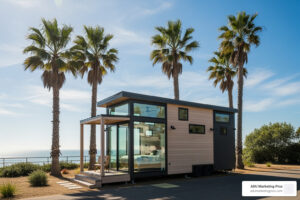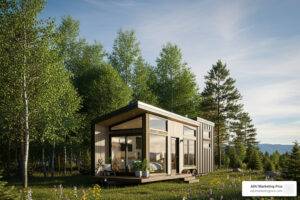Los Angeles ADU regulations have become a pivotal topic for many homeowners and developers eager to maximize property potential.
Here’s a quick look at what you need to know:
- ADU Benefits: Increase property value, generate rental income, and provide housing for family or caretakers.
- ADU Types: Options include Detached ADUs, Attached ADUs, Conversion ADUs, and Junior ADUs (JADUs).
- California State Law: Since 2017, a state law allows ADUs in most areas, expanding housing opportunities.
Accessory Dwelling Units (ADUs) are not just an architectural trend. They’re a smart response to California’s housing demand and regulatory shifts. For Los Angeles, navigating these regulations could open doors—literally and figuratively—to increased revenue and improved living spaces.
Understanding the types and benefits of ADUs is essential. They can boost property value substantially. A monthly rent of $1,000 could increase your property’s value by about $100,000. Whether you’re eyeing a detached unit, planning a garage conversion, or adding space for family members, knowing what each type offers is crucial.
On the legislative front, California’s progressive ADU laws are reshaping housing landscapes. The 2017 regulation was a game-changer by legalizing these units in most parts of the state, thus doubling potential housing capacity in some areas. This regulatory environment encourages maximizing land use, supporting both homeowners and communities.
Stay with us as we dig deeper into these elements and guide you through Los Angeles’s ADU regulations.

Los Angeles ADU regulations vocabulary:
– adu guidelines los angeles
Understanding Los Angeles ADU Regulations
Diving into the Los Angeles ADU regulations can feel overwhelming, but understanding them is crucial if you’re considering adding an ADU to your property. These regulations are designed to increase housing availability while maintaining neighborhood character.
Los Angeles ADU Ordinance
The ADU ordinance in Los Angeles outlines the specific requirements and conditions under which ADUs can be built. These rules are part of the city’s broader efforts to address the housing crisis by making it easier for homeowners to add these versatile units to their properties.
LAMC Section 12.03
One key regulation is found in LAMC Section 12.03, which defines what constitutes an ADU. This section is part of the Los Angeles Municipal Code, and it sets the groundwork for how ADUs are classified and what standards they must meet.
Key Points of LAMC Section 12.03:
- Definition: An ADU is a secondary housing unit with independent living facilities, including a kitchen and bathroom, located on the same lot as a primary residence.
- Location: ADUs can be built on most residentially zoned lots, regardless of property size. This flexibility is part of what makes them an attractive option for many homeowners.
- Types of ADUs: The section allows for various ADU types, including detached, attached, and conversion units, offering homeowners multiple options depending on their needs and property layout.

Recent Updates
Recent changes have eased restrictions, making it simpler and faster to get ADU projects approved. For instance, the updated guidelines eliminate parking requirements in certain areas and allow for a broader range of ADU designs. These updates are part of a broader state initiative to increase housing stock and provide more affordable living options.
Why It Matters
Understanding these regulations is essential for navigating the permitting process smoothly. With the right knowledge, you can avoid common pitfalls and ensure your project meets all necessary legal requirements, paving the way for a successful and compliant ADU construction.
Stay tuned as we explore the key changes in ADU laws that have further simplified the process for homeowners in Los Angeles.
Key Changes in ADU Laws
The landscape of Los Angeles ADU regulations has been shaped by several key legislative changes aimed at easing construction and increasing housing options. Here’s a snapshot of the most impactful laws:
AB 68
AB 68 is a game changer. It simplifies the process for building ADUs by reducing restrictions on size, setback, and parking requirements. This law allows homeowners to build larger ADUs and eliminates the need for additional parking if the property is near public transit. The goal? Make it easier and more appealing to add an ADU to your property.
AB 881
AB 881 further streamlines ADU approvals. It mandates that cities process ADU applications within 60 days, speeding up what was often a lengthy process. This law also restricts local governments from imposing overly burdensome regulations that could hinder ADU construction, ensuring a smoother path for homeowners.
SB 13
SB 13 addresses financial barriers by eliminating certain fees and reducing others. This law prohibits impact fees on ADUs smaller than 750 square feet, making it more affordable to build these units. It also provides an amnesty program for unpermitted ADUs, encouraging homeowners to bring these units up to code without facing hefty penalties.
AB 670
AB 670 targets homeowners associations (HOAs) by prohibiting them from banning ADUs. This law ensures that HOAs cannot impose restrictions that would prevent the construction of ADUs, giving homeowners more freedom to expand their living spaces.
AB 671
AB 671 focuses on affordability. It requires local governments to include plans for incentivizing and promoting ADU construction in their housing elements. This law aims to create more affordable housing options by encouraging the development of ADUs, which are typically less expensive than traditional housing.
These legislative updates reflect a broader push to address California’s housing crisis. By making it easier and more cost-effective to build ADUs, these laws aim to increase housing availability and provide more affordable options for residents.
Stay with us as we dig into the various types of ADUs you can build in Los Angeles and how these changes make it possible.
Types of ADUs in Los Angeles
When considering adding an accessory dwelling unit (ADU) to your property in Los Angeles, it’s important to understand the different types available. Each type has its own unique features and benefits. Here’s a breakdown:
Detached ADUs
Detached ADUs are standalone units separate from the primary residence. They are often located in the backyard and can offer more privacy. These units must adhere to size limitations, typically not exceeding 1,200 square feet.
- Pros: Provides maximum privacy and independence.
- Cons: Generally more expensive to build due to separate foundations and utilities.
Attached ADUs
Attached ADUs are extensions of the main house. They share a wall with the existing home, making them a popular choice for those looking to expand their living space without constructing a separate building.
- Pros: Less expensive than detached ADUs due to shared walls and utilities.
- Cons: Less privacy compared to detached units.
Conversion ADUs
Conversion ADUs involve changing existing spaces, like garages or basements, into living areas. This option is cost-effective since the structure already exists.
- Pros: Cost-effective as it uses existing structures.
- Cons: Limited by the size and shape of the existing space.
Junior ADUs (JADUs)
Junior ADUs are smaller units, maxing out at 500 square feet. They are typically created by converting part of the main house, like a bedroom or garage. A unique feature of JADUs is that they can share a bathroom with the main residence.
- Pros: Lower construction costs due to smaller size and shared amenities.
- Cons: Must have an efficiency kitchen and a separate entrance.

Understanding these types of ADUs can help you decide which option best suits your needs and property. Whether you’re looking for more privacy with a detached unit or a cost-effective solution like a conversion ADU, Los Angeles provides a variety of choices to expand your living space.
Next, we’ll explore the building and permitting process in Los Angeles, guiding you through the steps to bring your ADU project to life.
Building and Permitting Process
Building an Accessory Dwelling Unit (ADU) in Los Angeles involves several steps, each crucial to ensuring your project complies with local regulations. Let’s break down the building and permitting process to make it easy to understand.
ADU Permits
Before you start building, you need to secure the necessary permits. This is a critical step because without the right permits, your ADU could face legal issues or even be deemed uninhabitable. Permits ensure that your project meets safety standards and zoning laws.
- Application: Start by submitting an application to the Los Angeles Department of Building and Safety (LADBS). This includes detailed plans of your proposed ADU.
- Review Process: Once submitted, your application will go through a review process. Make sure your plans align with Los Angeles ADU regulations to avoid delays.
Los Angeles Department of Building and Safety (LADBS)
The LADBS is your go-to agency for all things related to building safety and permits in Los Angeles. They will guide you through the permitting process and ensure your ADU complies with the Los Angeles ADU regulations.
- Inspections: LADBS will conduct inspections throughout the construction process. These inspections ensure that your ADU is built safely and according to approved plans.
- Resources: The LADBS website offers resources and guidance to help you understand the requirements for your ADU project. It’s a valuable tool for homeowners and contractors alike.
Standard ADU Plans Program
To streamline the permitting process, Los Angeles County offers the Standard ADU Plans Program. This program provides pre-approved ADU designs that can save you time and money.
- County Catalog: Choose from a selection of pre-approved plans that have already been vetted by LA County Planning and Public Works. These plans are free and can significantly speed up the approval process.
- Private Designer Catalog: If you prefer a unique design, you can work with professional architects who offer pre-approved plans. This allows for some customization while still benefiting from an expedited review process.
By understanding and following these steps, you’ll be well on your way to successfully building your ADU in Los Angeles. Next, we’ll tackle some frequently asked questions about Los Angeles ADU regulations, helping you steer common concerns and challenges.
Frequently Asked Questions about Los Angeles ADU Regulations
What are the size and height restrictions for ADUs?
In Los Angeles, the maximum size for an Accessory Dwelling Unit (ADU) largely depends on the type of ADU and the lot size. Generally, you can build an ADU up to 1,200 square feet. However, all cities must allow a minimum of 800 square feet regardless of lot size.
When it comes to height restrictions, ADUs can be up to 16 feet tall. This allows for flexibility in design, especially if you’re considering a two-story ADU.
Setback requirements are essential to keep in mind. Typically, setbacks are about 4 feet from the side and rear property lines. These setbacks ensure that your ADU maintains a safe distance from neighboring properties and complies with fire safety regulations.
Are ADUs subject to rent control in Los Angeles?
The question of whether ADUs are subject to rent control in Los Angeles is a common concern. According to the Rent Stabilization Ordinance, newly constructed ADUs are generally exempt from rent control. This applies to both detached ADUs and attached ADUs. However, if your ADU is part of a larger, rent-controlled property, different rules may apply.
Can I build a two-story ADU in Los Angeles?
Yes, you can build a two-story ADU in Los Angeles. This option is ideal for maximizing space on smaller lots. Two-story ADUs can serve as independent living facilities, providing separate living spaces within the same property.
However, it’s important to ensure that your two-story design complies with the height and setback requirements mentioned earlier. Proper planning and consultation with the Los Angeles Department of Building and Safety (LADBS) can help steer these regulations effectively.
By understanding these frequently asked questions, you can better plan and execute your ADU project in Los Angeles. Next, we’ll explore more about the opportunities and challenges of ADU construction in the city.
Conclusion
As we’ve explored, Accessory Dwelling Units (ADUs) offer a fantastic opportunity for homeowners in Los Angeles. They provide additional living space, potential rental income, and can even increase your property value. However, navigating the Los Angeles ADU regulations can be complex, requiring a clear understanding of the rules and requirements involved.
This is where ADU Marketing Pros comes in. We specialize in providing digital marketing solutions custom for ADU construction and architecture firms. Our expertise helps your business stand out in a crowded market by emphasizing quality and expertise over price. Our team is dedicated to helping you attract high-quality leads and grow your revenue.
Whether you’re a homeowner looking to build an ADU or a business aiming to make a mark in this booming sector, understanding the regulations and leveraging digital marketing strategies is crucial. With ADU Marketing Pros, you get a partner who understands both the intricacies of ADU construction and the power of strategic marketing.
To learn more about how we can support your business with specialized marketing solutions, visit our ADU Marketing Solutions page.
By focusing on expert insights and innovative marketing, we aim to help you succeed in the dynamic world of ADU construction in Los Angeles.




